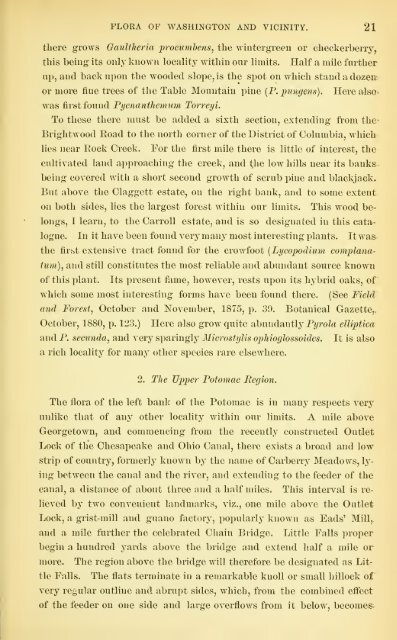Bulletin - United States National Museum - Smithsonian Institution
Bulletin - United States National Museum - Smithsonian Institution
Bulletin - United States National Museum - Smithsonian Institution
Create successful ePaper yourself
Turn your PDF publications into a flip-book with our unique Google optimized e-Paper software.
FLORA OF WASHINGTON AND VICINITY. 21<br />
there grows Gaultheria procumhens, the wintergreen or checkerberry,<br />
this being its only known locality within our limits. Half a mile further<br />
up, and back upon the wooded slope, is the spot on which stand a dozen;<br />
or more fine trees of the Table Mountain pine (P. pungens). Here also><br />
was first found Pycnantliemum Torreyi.<br />
To these there must be added a sixth section, extending from the-<br />
Brightwood Eoad to the north corner of the District of Columbia, which,<br />
lies near Eock Creek. For the first mile there is little of interest, the<br />
cultivated land approaching the creek, and the low hills near its banks<br />
being covered with a short second growth of scrub pine and blackjacks<br />
But above the Claggett estate, on the right bank, and to some extent<br />
on both sides, lies the largest forest within our limits. This wood be-<br />
longs, I learn, to the Carroll estate, and is so designated in this cata-<br />
logue. In ithavebeenfound very many most interesting plants. It was.<br />
the first extensive tract found for the crowfoot {Lycopodium complana-<br />
tum), and still constitutes the most reliable and abundant source known<br />
of this plant. Its present fame, however, rests upon its hybrid oaks, of<br />
which some most interesting forms have been found there. (See Field'<br />
and Forest, October and November, 1875, p. 39. Botanical Gazette^<br />
October, 1880, p. 123.) Here also grow quite abnndantly Pyrola elliptica<br />
and P. secunda, and very sparingly Microstylis opMoglossoides. It is also<br />
a rich locality for many other species rare elsewhere.<br />
2. The Upper Potomac Region.<br />
The flora of the left bank of the Potomac is in many respects very<br />
unlike that of any other locality within our limits. A mile above<br />
Georgetown, and commencing from the recently constructed Outlet<br />
Lock of the Chesapeake and Ohio Canal, there exists a broad and low<br />
strip of country, formerly known by the name of Carberry Meadows, ly-<br />
ing between the canal and the river, and extending to the feeder of the<br />
canal, a distance of about three and a half miles. This interval is re-<br />
lieved by two convenient landmarks, viz., one mile above the Outlet<br />
Lock, a grist-mill and guano factory, popularly known as Eads' Mill,<br />
and a mile further the celebrated Chain Bridge. Little Falls proper<br />
begin a hundred yards above the bridge and extend half a mile or<br />
more. The region above the bridge will therefore be designated as Lit-<br />
tle Falls. The flats terminate in a remarkable knoll or small hillock of<br />
very regular outline and abrupt sides, which, from the combined effect<br />
of the feeder on one side and large overflows from it below, become&i

















